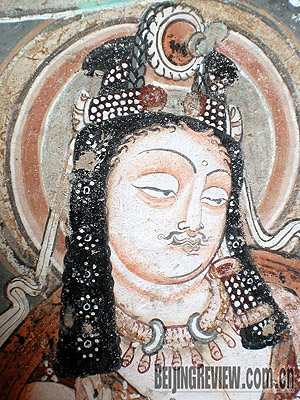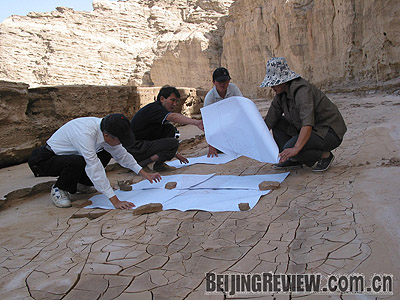|
"We often neglected this kind of basic work in the past and thought it would not bring practical benefits for heritage preservation, but now we know we were wrong," he said.
Experts of both countries also agreed that protecting cultural heritage is the responsibility of each successive generation.
The Kumtura Thousand Buddha Caves
First dug out in the fourth century, the Kumtura Thousand Buddha Caves are groups of grottoes lying along a hill on the east bank of the Weigan River, 30 km to the southwest of Kuqa County, Xinjiang Uygur Autonomous Region of China. In Uygur language, Kumtura means "a beacon tower in the desert."
 |
|
PORTRAIT OF PEACE: A section of a fresco in the Kumtura Thousand Buddha Caves | Extending about 3 km from north to south, the grottoes are parts of the site of a Qiuci (an ancient state in the area of China's Xinjiang and parts of Central Asia today) Buddhist temple in the past. It is recorded that the earliest cave was chiseled 1,500 years ago. There are 144 numbered caves in the site and more than 4,000 square meters of frescoes.
Most of the caves and frescoes were created between the third century and the 11th century, a period witnessing the growth and acceptance of Buddhism in China. The caves were carved by the Turkish, Han, Uygur and Tibetan people and present a blending of Eastern and Western art forms, which have outstanding historical, scientific and artistic value.
 |
|
PIECE BY PIECE: Experts from China and Japan discuss the restoration plan | After more than 1,500 years of wars and natural disasters, the caves still hold an excellent collection of Qiuci Buddhist art. Because of the unique position in the world of Buddhist culture, the site was included in the list of cultural relics under state-level protection by the State Council of China in 1961.
In the early 20th century, many foreign expeditions visited the caves, moving part of the frescoes to the West. After the founding of the People's Republic of China in 1949, the scientific investigation of the caves began. Since the 1970s, the Chinese Government has organized four large-scale scientific inspection teams to visit Xinjiang to carry out research work at the site, including the history and religious importance of the caves, and the themes and art styles of the frescoes in the caves.
Now, the desert climate, the erosion by the sand and wind and the geologic activities of the region have left most caves in danger of collapse, adding much urgency to their preservation.
(Source: Unescobeijing.org)
|
